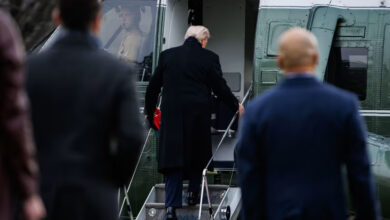
CEYLANPINAR, Turkey (AP) — Russia moved to fill the void left by the United States in northern Syria, deploying troops Tuesday to keep apart advancing Syrian government and Turkish forces. At the same time, tensions grew within NATO as Turkey defied growing condemnation from its Western allies of its invasion across the border.
Now in its seventh day, Turkey’s offensive against the Kurds has upended alliances and is re-drawing the map of northern Syria for yet another time in Syria’s 8-year-old war.
US rival Russia was quickly moving to entrench its de facto power broker role after President Donald Trump ordered the pullout of American forces in northeast Syria. The American move effectively abandoned the Kurdish fighters allied with the US and opened the door for the Turkish invasion aimed at crushing them.
Desperate for a new protector, the Kurdish administration struck a deal with the Russian-backed government of Syrian President Bashar Assad, whose forces began on Sunday deploying in Kurdish-administered areas to shield them against Turkey.
A video posted online by Russian journalists travelling with the soldiers showed what appeared to be an abandoned outpost where American troops had been stationed earlier. Syrian troops waved flags in the city streets.
Outside Manbij, Russian troops began patrolling front lines between Turkish and Syrian army positions to keep them separated, Russia’s Defense Ministry said.
“No one is interested” in potential fighting between Syrian government troops and Turkish forces, Russia’s envoy for Syria Alexander Lavrentyev told Russian state news agencies. Russia “is not going to allow it,” he said.
Lavrentyev confirmed that Kurdish leaders and representatives of the Syrian government held talks at a Russian military base last week but said that he was not aware of any results.
Still, fighting flared near Manbij, a town west of the Euphrates River that Turkey has long wanted to wrest from Kurdish control. A mortar attack from Manbij hit Turkish forces, killing one soldier and wounding eight others, Turkey’s Defense Ministry said. The Turkish military retaliated with an assault that “neutralized” an estimated 15 Syrian Kurdish fighters, the ministry added.
Further east along the border, Kurdish fighters battled trying to retake the town of Ras al-Ayn, which was captured by Turkish forces days earlier. An Associated Press journalist reported heavy Turkish bombardment of targets in the countryside around Ras al-Ayn early Tuesday.
The Syrian Observatory for Human Rights, a war monitoring group, reported that Syrian Kurdish fighters had retaken the town. But it appeared it was still being contested, and Turkish media said the military was responding to attempts by the Kurdish fighters to infiltrate Ras al-Ayn.
Russia and Assad’s stride into place alongside the once US-allied Kurds came as the United States tried to restrain the invasion by fellow NATO member Turkey.
Targeting Turkey’s economy, Trump on Monday announced sanctions aimed at restraining the Turks’ assault. The United States also called on Turkey to stop the offensive and declare a cease-fire, while European Union countries moved to broaden an arms sale embargo against their easternmost ally.
Washington said Trump was sending Vice President Mike Pence and national security adviser Robert O’Brien to Ankara as soon as possible in an attempt to begin negotiations over a stop to the fighting. Pence said Trump spoke directly to Turkish leader Recep Tayyip Erdogan, who promised not to attack the border town of Kobani, which in 2015 witnessed the Islamic State group’s first defeat in a battle by US-backed Kurdish fighters.
Erdogan defended Turkey’s offensive in an op-ed in the Wall Street Journal, calling on the international community to support Turkey’s effort to create what it calls a resettlement “safe zone” for refugees in northeast Syria, or “begin admitting refugees.”
“Turkey reached its limit,” Erdogan wrote in reference to 3.6 million Syrian refugees in his country. He said Turkey’s warnings that it would not be able to stop refugee floods into the West without international support “fell on deaf ears.”
Turkey invaded northern Syria aiming to create a zone of control the entire length of the border and drive out the Kurdish fighters, which it considers terrorists because of their links to Kurdish insurgents within Turkey.
Instead, after the Kurds’ deal with Damascus, a new de facto carving up of the border appeared to be taking shape.
Turkish forces control a truncated zone roughly in the center of the border about 100 kilometers (60 miles) long between the towns of Tel Abyad and Ras al-Ain.
Syrian government troops were moving into or beefing up their presence in the regions on either side of that enclave, including Manbij west of it, and the cities of Qamishli and Hassakeh in the far northeastern corner of Syria.
With their deal with Damascus, the Kurds risk losing the virtual self-rule they have enjoyed across the northeast — the heartland of their minority community — ever since Assad had to pull his troops out of the area seven years ago to fight rebels elsewhere. They are hoping, perhaps with Russian mediation, to reach a final deal that would preserve some degree of that autonomy.
But they gain protection: So far, Turkey appears reluctant to clash with Syrian forces wherever they move in.
The main Kurdish-led force in Syria said it has lost 23 fighters in clashes with advancing Turkish-led forces over the past day, mainly at Ras al-Ayn and Tal Abyad. That raises the total of casualties announced by the group to 68 dead.
Separately, two people were killed in a new mortar and rocket attack by Syrian Kurdish fighters on a Turkish town bordering Syria, local officials said. The attack on the town of Kiziltepe, Mardin province, also wounded 12 other civilians, the governor’s office said.
Turkish officials say 18 civilians — excluding Tuesday’s victims — have been killed in a barrage of mortar and rocket shells fired on towns located on the Turkish border provinces of Mardin, Sanliurfa, Sirnak and Gaziantep, since the operation began on Oct. 9.
The UN humanitarian aid coordinator said at least 160,000 civilians in northeastern Syria have been displaced amid the Turkish operations, mostly from Ras al-Ayn and Tal Abyad, where people are fleeing south.
Separately, spokesman Rupert Colville of the UN human rights office said it was “not seeing large numbers of civilian casualties” so far — “a few each day” — but people were being killed on both sides of the Syria-Turkey border.
He cautioned: “Obviously we’re not necessarily hearing all cases, either.”
__
By LEFTERIS PITARAKIS and BASSEM MROUE. Mroue reported from Beirut. Associated Press writers Nataliya Vasilyeva in Moscow and Suzan Fraser in Ankara, Turkey, contributed.
Image: In this photo taken from the Turkish side of the border between Turkey and Syria, in Ceylanpinar, Sanliurfa province, southeastern Turkey, smoke and dust billows from targets in Ras al-Ayn, Syria, caused by bombardment by Turkish forces, Tuesday, Oct. 15, 2019. Turkish artillery on Tuesday pounded suspected Syrian Kurdish positions near the town in northeast Syria amid reports that Kurdish fighters had retaken the town as Turkey pressed ahead with a military incursion that has drawn widespread condemnation. (AP Photo/Lefteris Pitarakis)




